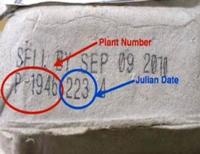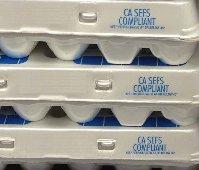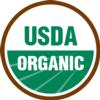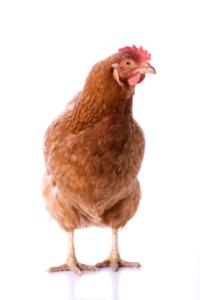Selling Fresh Shell Eggs
The sale of raw shell eggs sold from your property, at Certified Farmer's Market, grocery stores, restaurants and institutions are covered by this fact sheet. California Department of Food & Agriculture (CDFA) administers this program.
- Eggs must be from hens under your ownership and care.

- Complete an Egg Handlers Registration - no exceptions! Everyone selling shell eggs must register. NOTE: as of 1/2019, all species of fowl must register.
- Registration fee: $75
- Annual renewal fee: $50
Business type:
- Producers raise the layers and collect the eggs
- Packers package the eggs for sale
- Producer/Packers do both - most small farms are this type - California Shell Egg Food Safety Regulation Guidance
- If you will be selling at a Certified Farmers Market, you will also need to complete a Certified Producers Certificate Application.
Visit CDFA's Small Producer Outreach Program page for upcoming workshops. COVID update: CDFA will be offering Zoom classes in the future.
Until USDA Create Rules
The following information applies to species as follows:
Chickens: grading, sizing, temperature controls and CASEFS Compliance.
ALL: Cleanliness, management claims, Egg Safety Rule and IRQ label requirements.
Label Requirements
The following are requirements for Standard 12-18 egg cartons:

NOTE: when selling in bulk/allowing customers to choose individual eggs, the following information is required to be on a sign with the eggs:
- I.R.Q:
Identity (Eggs)
Responsibility (Farm name, address and zip code)
Quantity (Number of eggs in the container) - Sell-by Date:
Date shall not exceed 30 days from the date on which the eggs were packed (excluding the day of pack) - Julian Date of Pack:
The consecutive date of the year on which the eggs were packed. Example: Jan 1 = 001, Jul 1 = 182, Dec 31 = 365. - Plant Identification Number (Egg Handlers Registration number)
- Grade - AA, A, B (see USDA Shell Egg Grades & Standards)
- Size - Jumbo, Extra Large, Large, Medium, Small, Peewee (see USDA Shell Egg Grades & Standards)
- Prominently Labeled: Refrigerate After Purchase
Additional Label Requirements
- One size and grade shall appear upon a container.
 *NEW* CA SEFS Compliant
*NEW* CA SEFS Compliant - Size and grade shall be plainly marked in letters not less than 1/4 inch in height.
- "CASEFS COMPLIANT" must be 1/4 inch in size.
Reduced Stocking Density takes effect 1/1/2015 see page 2 of CDFA Shell Egg Food Safety Regulation Guidance - Descriptions or other amplification of grade or size are not permitted on containers:
Prohibited words related to grade include, but not limited to: Fancy, select, premium, superior
Prohibited words related to size include, but not limited to: oversize, giant - Descriptive terms such as polyunsaturated, plus polyunsaturates, higher in iodine, flavored with iron, omega 3 or other wording indicating a quality or ingredient different than found in a normally produced egg may not appear in labeling unless approved by the Agricultural Commissioners office.
- CDFA recommends NOT re-using egg cartons because of health risks.
Label Approval
Producers can email their label to CDFA for approval prior to use: CDFA.ESQM_Inquiries@cdfa.ca.gov
Poultry Management Claims
The terms cage free and pasture-raised are currently unregulated. USDA requires that in order to use the term free range, producers must demonstrate that the poultry have access to the outside. Labels that claim Certified Humane, Animal Welfare Approved and American Humane Certified all require certification from the respective organizations.
Organic:

- Gross sales up to $5,000 of organic produce/eggs, you can be registered only. This allows you to use the term 'organic' on your label, but you cannot use the USDA Organic seal.
- Gross sales over $5,000 of organic produce/eggs, you must become third party Certified in addition to the CDFA Organic registration. See CDFA's Organic Program page, scroll to Organic Certifier's List. You must use a CDFA approved certifier.
Egg Grade Standards

Grade AA: The shell must be clean and unbroken. The air cell is limited to 1/8 inch depth at original and 3/16 inch at destination. The white must be clear and the yolk practically free of apparent defects.
Grade A: The shell must be clean and unbroken. The air cell is limited to 3/16 inch depth at original and 1/4 inch at destination. The white must be clear and the yolk practically free of apparent defects.
Grade B: The shell must be clean and unbroken and may have unlimited slight stains (but not dirt clinging to shell). The air cell may not exceed 3/8 inch. The white must be clear and the yolk practically free of apparent defects. The white may be weak and watery and the yolk outline plainly visible the yolk may appear dark, enlarged and flattened. It may show other serious defects which do not render the egg inedible.
Cleaning Eggs: eggs must be cleaned prior to sale. Submerging eggs is NOT recommended. Make sure eggs are dry before placing in carton. See this video from a small producer workshop with CDFA for Egg Safety including washing and candling eggs (starting at 31:20).
More Information about Grading
The grade of a shell egg is determined by the size of the internal air-cell. As an egg ages, the liquid contents evaporate through its pores. The larger the air-cell is, the lower the grade of the egg. The outside appearance also factors into the grade of an egg. Eggs with moderate staining (but not adhering dirt) can be sold as grade "B." All other grades require a clean, unblemished shell appearance. Dirty eggs cannot be sold to consumers. The size of an egg is determined by its weight, in grams. A small egg must weight 40.16 grams or more, a jumbo egg must weigh 68.51 grams or more.
Egg Size Standards
Size tells you the minimum required weight of the smallest egg in the dozen. It does not refer to the dimensions of an egg or how big it looks. While some eggs in the carton may look slightly larger or smaller than the rest, it is the weight that determines the size indicated on the carton:
| Size or Weight Class | Min Weight per Egg |
Size or Weight Class |
Min Weight |
|
| Jumbo | 2.42 ounces | Medium | 1.67 ounces | |
| Extra Large | 2.17 ounces | Small | 1.42 ounces | |
| Large | 1.92 ounces | Peewee | no min |
NOTE: If you are unsure of the size of your eggs, label them the smallest size. For example, if you have at least medium sized eggs, label the carton as Medium. It is acceptable to have larger sized eggs in the carton.
Egg Safety Final Rule
Egg production falls under the Food & Drug Administration's Egg Safety Final Rule to prevent foodborne illness due to the consumption of eggs contaminated with the bacterium Salmonella Enteritidis.
The Egg Safety Final Rule applies to operations that do not process their eggs with some type of treatment (e.g. pasteurization) and have 3,000+ laying hens and/or handle 12,000+ cases per year (1 case = 30 dozen).
- FDA Egg Rule at a Glance
- Guide: Prevention of Salmonella Enteritidis in Shell Eggs During Production, Transportation, and Storage
- PART 118—Production, Storage, and Transportation of Shell Eggs
Small scale operations are 'exempt' from the inspections, but they are not exempt from following guidelines for food safety. "Small scale" = <3,000 laying hens.
- Biosecurity to prevent the spread of disease
- Salmonella Prevention Measures by FDA (small producers are exempt, this is just for your information)
Temperature Control
The refrigeration regulations technically only apply to chicken eggs, however CDFA strongly encourages those who handle other eggs to follow the same refrigeration practices.
Per Cal Code (California Retail Food Code):
Raw shell eggs should be held at or below 45°F.
However, raw shell eggs may be stored and displayed without refrigeration if ALL of the following conditions are met:
- The eggs were produced by poultry owned by the seller and collected on the seller's property.
- The eggs are not placed in direct sunlight during storage or display.
- Retail egg containers are prominently labeled "refrigerate after purchase" or the seller posts a conspicuous sign advising consumers that the eggs are to be refrigerated as soon as practical after purchase.
- Retail egg containers are conspicuously identified as to the date of the pack.
- The eggs have been cleaned and sanitized*
- The eggs are not checked, cracked, or broken.
- Any eggs that are stored and displayed at temperatures of 90°F or below and that are unsold after four days from the date of pack shall be stored and displayed at an ambient temperature of 45°F or below, diverted to pasteurization, or destroyed in a manner approved by the enforcement agency.
- Any eggs that are stored and displayed at temperatures above 90°F that are unsold after four days from the date of pack shall be diverted to pasteurization or destroyed in a manner approved by the enforcement agency.
*Cleaning and Sanitizing Eggs
From a presentation on SEFS Compliant Training:
Egg Cleaning Procedures for Small On-Farm Operations
0 BASKET SUBMERSION TYPE-(This machine is primarily used for on farm egg washing and Usually holds between four and ten gallons of solution.)
- Eggs should be gathered frequently and should be washed immediately after collection.
- It is important that the wash water be 20°F higher that the egg temperature. Use only those machines where the temperatures can be regulated and monitored by thermometer. Suggested temperatures are between 110°F and 125°F. Follow the manufacturer’s instructions and never let the temperatures fall below 110°F.
- Use good quality detergent. The amount is dependent on the capacity of the machine. Do not use household detergents –they may cause undesirable flavors in the eggs. Follow the manufacturer’s recommendations for the amount and kind of detergent to use.
- Eggs should not be immersed longer than is necessary to clean them. Depending upon how bad the eggs are soiled, two to three minutes should be ample time. Because egg contents damaged by prolonged exposure to high water temperatures, a timing device should be used to avoid leaving eggs in the machine for more than three minutes. Depending upon the make and model of egg washer, as well as the degree of soiled eggs, no more than two to five baskets of eggs should be washed before replacing the solution.
About Disinfectants from Small Flock Egg Producers Workshop
Disinfectants recommended by the USDA-APHIS that are effective against both HPAI and SE, and are more appropriate to the poultry house environment and high organic matter load in their "Biosecurity Guide for Poultry and Bird Owners" include:
- Roccal: mixed at one-half fluid ounce per gallon of water
- NQlvasan (chlo'rhexidine diacetate 2%): mixed at three fluid ounces per gallon of water
- Tek-trol:' mixed per manufacturer's instructions.
- One Stroke Environ: mixed per manufacturer's instructions
- Household bleach (sodium hypochlorite 6%): mix three-fourth of a cup of bleach per gallon of water
- Lysol spray for footwear
- Purell hand pump for hand disinfection
In order for most disinfectants to work properly the object to be disinfected must be thoroughly cleaned and washed prior to being disinfected. Disinfectants should be applied using brushes, sponges, or spray units and appropriate contact times should be allowed (follow manufacturer's instructions).
Getting Started in Business
There are many additional requirements for business operations. To get started, visit:

Additional Resources
- UCCE Poultry resources for small-scale and commercial production operations and for back yard poultry enthusiasts.
- UC Davis Vet Med Poultry University YouTube channel with many educational videos for poultry producers and enthusiasts.
- Backyard Poultry Central app - yes, there's an app for that - on Google Play only.
- Small Flock Producers Workshop guide from CDFA
- Egg Safety & Quality Management Program California Department of Food & Agriculture
- Shell Egg Grades & Standards by USDA
- Pasture-Based Poultry by UCCE Foothill Farming with resources for both egg production and meat birds
- Pasture Poultry Workshop held Oct 2015 presentations
- Small and Backyard Flocks by eXtension all aspects of raising poultry
- American Pastured Poultry Producers Association
Have a question?
Ask the Ag Ombudsman
Collaboration
Specific information contained herein has been verified by CDFA and Sonoma County Agricultural Commissioner Office.


